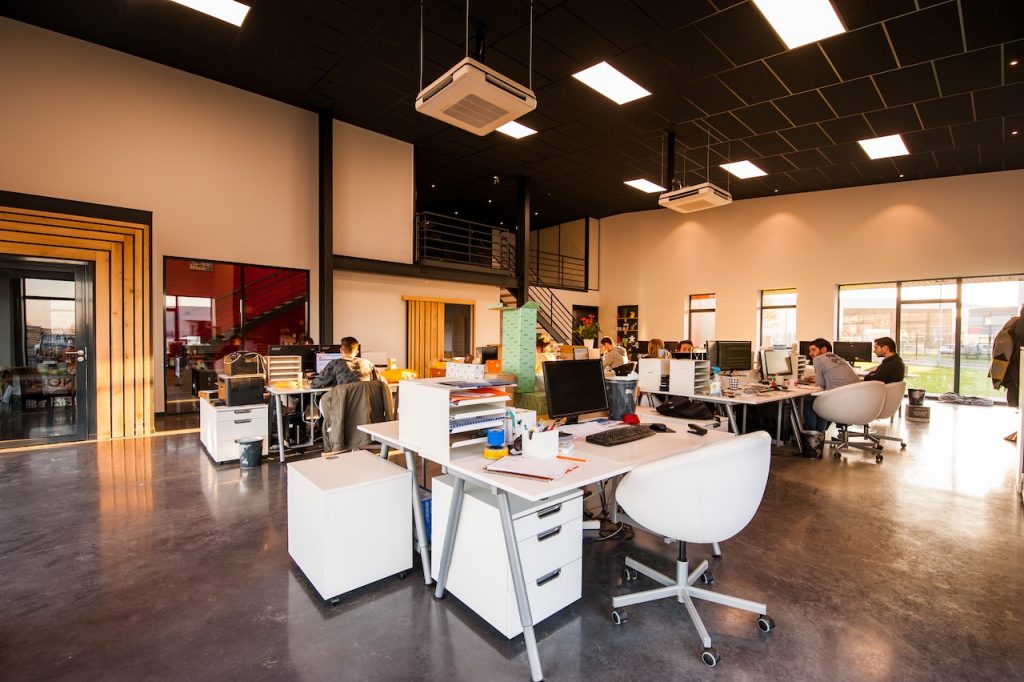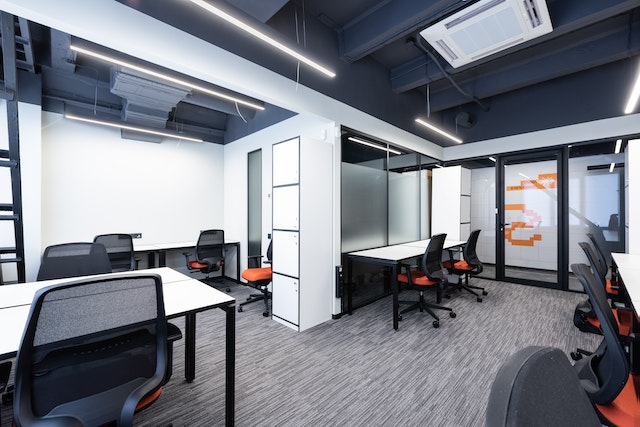Imagine walking into a vibrant, well-lit space – a place where every corner is meticulously illuminated, making it feel inviting and comfortable. Now, contrast this with a poorly lit room, where the shadows are prominent and the atmosphere is less than welcoming. The difference between these two experiences underscores the power and importance of appropriate lighting. It becomes even more crucial in a commercial setting where lighting can impact everything from productivity and employee satisfaction to energy consumption and customer experience.
In the world of commercial lighting, one technology has stood out in recent years for its efficiency, cost-effectiveness, and sustainability – Light Emitting Diodes, or more commonly known as LED lights. LED lighting has been revolutionizing the illumination landscape, offering solutions that outshine their conventional incandescent or fluorescent counterparts.
In this comprehensive guide, we’ll explore the world of LED lighting for commercial spaces. We’ll delve into the reasons that make LEDs an excellent choice, explore different types of LED lights, consider key factors in choosing LED lights, and even provide a guide to calculate the number of LED lights you might need for your commercial space.
Whether you’re an entrepreneur looking to cut down on energy costs, a business manager wanting to improve your workspace, or a property owner keen on making a sustainable choice, this guide will illuminate the path to achieving your goals with LED lighting.
Why LED Lights for Commercial Spaces?

When it comes to selecting lighting for commercial spaces, you need a solution that combines cost-effectiveness, energy efficiency, longevity, and quality. LED lights outshine many traditional lighting options on these fronts. Here’s why LED lights are an excellent choice for commercial spaces:
1. Energy Efficiency: LEDs are champions of efficiency. They convert up to 95% of energy into light, wasting only 5% as heat. Contrast this with incandescent bulbs that convert only about 10% of energy into light, squandering the remaining 90% as heat. What does this mean for your business? With LEDs, a significant chunk of your electricity consumption converts into usable light, not wasted heat, leading to substantial savings on energy bills. This high efficiency is particularly beneficial in commercial settings where lights are on for extended periods.
2. Long Lifespan: LED lights are known for their long lifespan. They can last up to 50,000 hours, sometimes even more, depending on the usage and model. In a commercial setting, where lights are often operational for a large part of the day, this extended lifespan means less frequent replacement. Not only does this lower the costs associated with buying new lights, but it also reduces maintenance costs.
3. Superior Light Quality: LED lights offer superior light quality compared to traditional lighting solutions. They provide brighter, uniform light distribution, ensuring no areas are left dim or poorly lit. Additionally, they come in a range of color temperatures and have better Color Rendering Index (CRI) scores, meaning they can more accurately reproduce the color of objects as compared to natural light.
4. Eco-Friendly: As businesses across the globe strive to be more sustainable, switching to LED lights is an effective step towards this goal. LEDs consume less power, reducing their carbon footprint. They also last longer, meaning less waste from light bulb replacements. Moreover, unlike compact fluorescent lights (CFLs), they do not contain harmful mercury, making them safer to use and dispose of.
5. Instant Lighting & Frequent Switching: LED lights light up immediately at their full brightness once switched on, with no warm-up period required. This is a stark contrast to many traditional lights that take several minutes to reach full brightness. Additionally, LEDs can handle frequent on/off cycles without degradation, making them ideal for commercial spaces where lights may be switched on and off regularly.
6. Versatility: LEDs are highly adaptable and can be designed for virtually any lighting application due to their size and efficiency. This versatility allows businesses to create tailored lighting solutions to meet their unique needs.
LED lights offer businesses a way to maintain high-quality lighting while saving on energy costs, reducing maintenance efforts, and contributing positively to the environment.
Different Types of LED Lights
One of the main reasons LED lights have become so popular in commercial spaces is their versatility. They come in a wide variety of types, each designed to meet specific lighting needs. Here are some commonly used LED light types in commercial settings:
1. LED Panels: LED panel lights are typically square or rectangular and provide even, uniform, and bright lighting. They are an ideal replacement for traditional fluorescent ceiling lights. The diffuser on LED panels ensures that the light is spread over a large area, making it ideal for offices, retail stores, hospitals, and educational institutions.
2. LED Tubes: LED tube lights are designed to replace traditional fluorescent tube lights. They provide better energy efficiency, longer lifespan, and superior light quality. They’re often used in offices, garages, warehouses, and any other places where long, linear lighting is required.
3. LED Downlights: Also known as pot lights or recessed lights, LED downlights are installed into the ceiling, providing a sleek and modern look. These lights emit light in a downward direction, giving a narrow spotlight kind of effect. They’re perfect for creating a warm and welcoming atmosphere in places like hotels, restaurants, and residential buildings.
4. LED High Bay Lights: As the name suggests, LED high bay lights are designed for spaces with high ceilings, typically 20 feet or more. They provide bright and uniform lighting, making them an excellent choice for warehouses, factories, gyms, and retail stores with high ceilings.
5. LED Strip Lights: LED strip lights, also known as LED tape or ribbon lights, are flexible circuit boards populated by surface mounted light-emitting diodes (SMD LEDs) and other components. They are perfect for accent lighting, back-lighting, pathway lighting, and decorative lighting on ceilings, walls, and other tight spaces.
6. LED Bulbs: LED bulbs are the most common type of LED light. They come in a variety of shapes, sizes, and fittings and are designed to replace traditional incandescent or CFL bulbs. They are used in various settings, including offices, retail stores, hotels, and more.
7. LED Spotlights: LED spotlights produce a narrow beam of light that can be directed at specific areas or objects. They’re used in many commercial settings for accent lighting, such as highlighting product displays in retail stores or artworks in a gallery.
Each of these LED types offers unique benefits and can be used to create optimal lighting conditions for various commercial spaces. When choosing an LED light type, consider factors such as the size of the space, the ceiling height, the desired lighting effect, and the specific lighting needs of the business.
Factors to Consider When Choosing LED Lights

Choosing the right LED lights for your commercial space is not as simple as picking the first option you come across. Several factors come into play to ensure you make the most out of your investment. Here are the key considerations:
1. Size and Layout of the Space: The size and layout of your space will largely determine the type and number of LED lights you need. Larger spaces will typically require more powerful lights or a greater number of lights to sufficiently illuminate the area. The layout is also essential – consider where the lights will be placed for optimal illumination.
2. Type of Business: Different businesses have different lighting needs. For instance, an art gallery might require LED spotlights with high Color Rendering Index (CRI) scores to accurately portray artwork, while an office space might need bright, cool white LED panels to maintain productivity.
3. Color Temperature: LED lights come in a range of color temperatures, usually measured in Kelvins (K). Lower temperatures (2700-3000K) produce a warm, cozy light that’s often used in hotels, restaurants, and residential spaces. On the other hand, higher temperatures (4000-6500K) produce a cool, bright white light ideal for task-oriented spaces like offices, retail stores, or hospitals.
4. Luminous Efficacy (Lumens/Watt): Luminous efficacy refers to how much light a bulb produces for each watt of electricity. In simple terms, it’s a measure of an LED light’s efficiency. Look for LED lights that offer high lumens for less wattage, as these will be the most energy-efficient.
5. Color Rendering Index (CRI): CRI is a measure of a light source’s ability to reveal the actual color of objects as compared to an ideal light source like natural light. A high CRI is desirable as it means the light source accurately represents different colors. For businesses where color accuracy is important, such as retail stores or art galleries, LEDs with a high CRI are recommended.
6. Dimmability: Depending on the nature of your commercial space, you might require lights with dimming capabilities. LED lights are available in dimmable versions, allowing you to adjust the light intensity as per your needs.
7. Lifespan and Warranty: Always check the expected lifespan of an LED light before purchasing. Most quality LEDs have a lifespan of 25,000 to 50,000 hours, significantly outlasting traditional light sources. Also, consider the warranty provided by the manufacturer, which can serve as a guarantee of the product’s durability.
8. Safety and Certifications: Ensure that the LED lights you choose meet all safety standards and have the necessary certifications. Lights should be tested and certified by recognized testing laboratories to ensure they are safe to use.
By considering these factors, you can select LED lights that not only meet your illumination needs but also contribute to the overall efficiency, aesthetics, and functionality of your commercial space.
How to Calculate the Number of LED Lights Needed
After understanding the types of LED lights and the factors to consider, the next crucial step is determining the number of LED lights required for your commercial space. Having the right number of lights ensures your space is adequately lit without unnecessarily escalating energy costs. Here’s a simple guide on how to calculate this:
1. Calculate the Total Lumen Requirement: Start by calculating the total lumen requirement for your space. Lumens measure the amount of visible light emitted by a source. Different types of spaces require different lumen levels. For instance, a retail store might require around 50 lumens per square foot, while a warehouse could require 30 lumens per square foot. Multiply the total square footage of your space by the required lumens per square foot to get your total lumen requirement.
2. Check the Lumen Output of the LED Light: Next, check the lumen output of the LED light you plan to use. This is usually mentioned on the LED light packaging or product description.
3. Determine the Number of Lights Needed: Divide your total lumen requirement by the lumen output of the LED light. The resulting number will give you a rough estimate of the number of LED lights needed to adequately illuminate your commercial space.
For example, if your retail store is 1000 square feet and requires 50 lumens per square foot, your total lumen requirement is 50,000 lumens. If the LED light you chose has a lumen output of 1600 lumens, you would need approximately 31 LED lights (50,000 divided by 1600).
Keep in mind, this calculation provides a rough estimate. Other factors like the layout of the space, the color of the walls and ceiling, and the presence of natural light can affect the number of lights needed. You might need fewer lights if your space has a lot of natural light or lighter colored walls, and more if the space has darker colored walls and little to no natural light.
When in doubt, it’s always beneficial to consult with a lighting designer or a professional with experience in commercial lighting. They can provide a more accurate assessment of your lighting needs based on the specific characteristics of your space.
The Bright Future of LED Lighting in Commercial Spaces
The shift towards LED lighting in commercial spaces is more than just a trend; it’s a testament to the myriad advantages that this technology brings. From energy efficiency and cost savings to improved light quality and reduced environmental impact, the benefits are tangible and significant.
Choosing the right LED lights for your commercial space might seem like a daunting task, but with the right knowledge and guidance, it can be simplified. By understanding the different types of LED lights, considering crucial factors like your space’s size, the type of business, and the desired light temperature, and calculating the number of lights needed, you can make an informed decision.
Real-life implementations, like the shopping mall case study we discussed, prove that well-planned LED lighting upgrades can enhance the aesthetics of a space while driving down costs and contributing to sustainability efforts.
As we advance towards a more energy-conscious future, LED lighting stands out as a powerful tool for businesses to create engaging spaces, improve their bottom line, and reduce their carbon footprint. Embracing LED technology is not just about keeping up with the times; it’s about paving the way for a brighter, more sustainable future.



